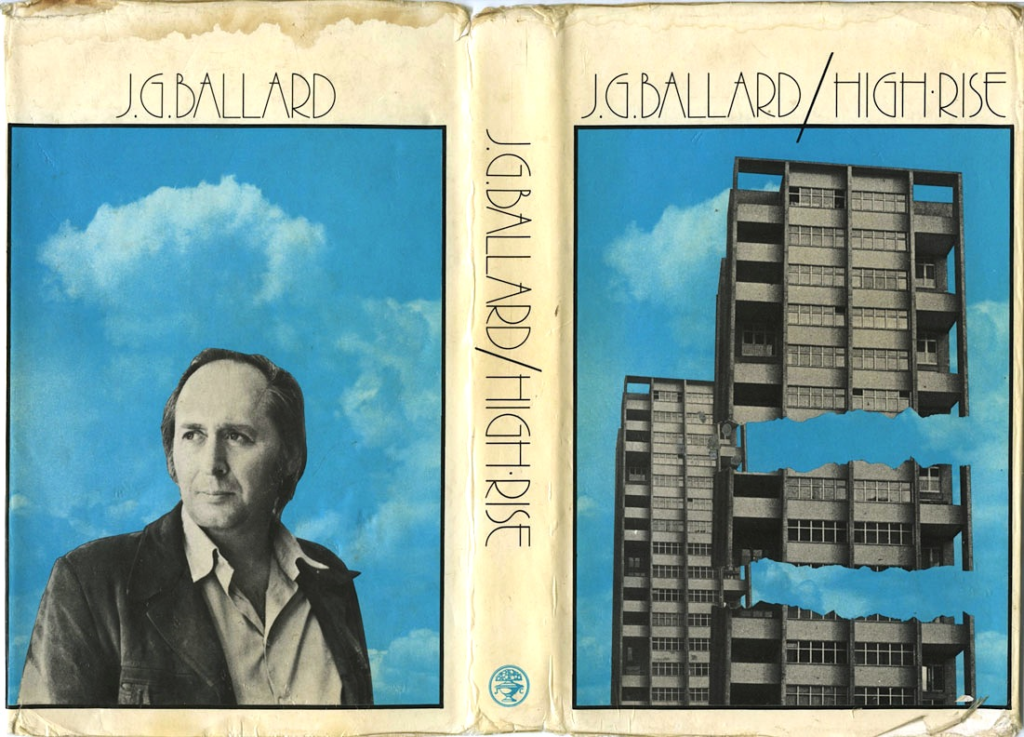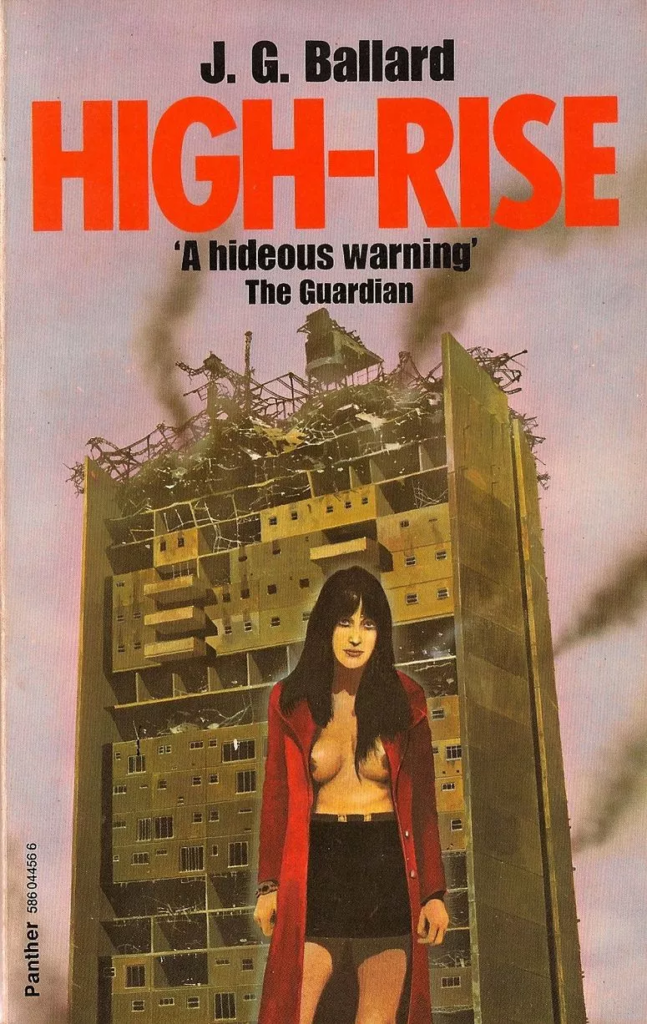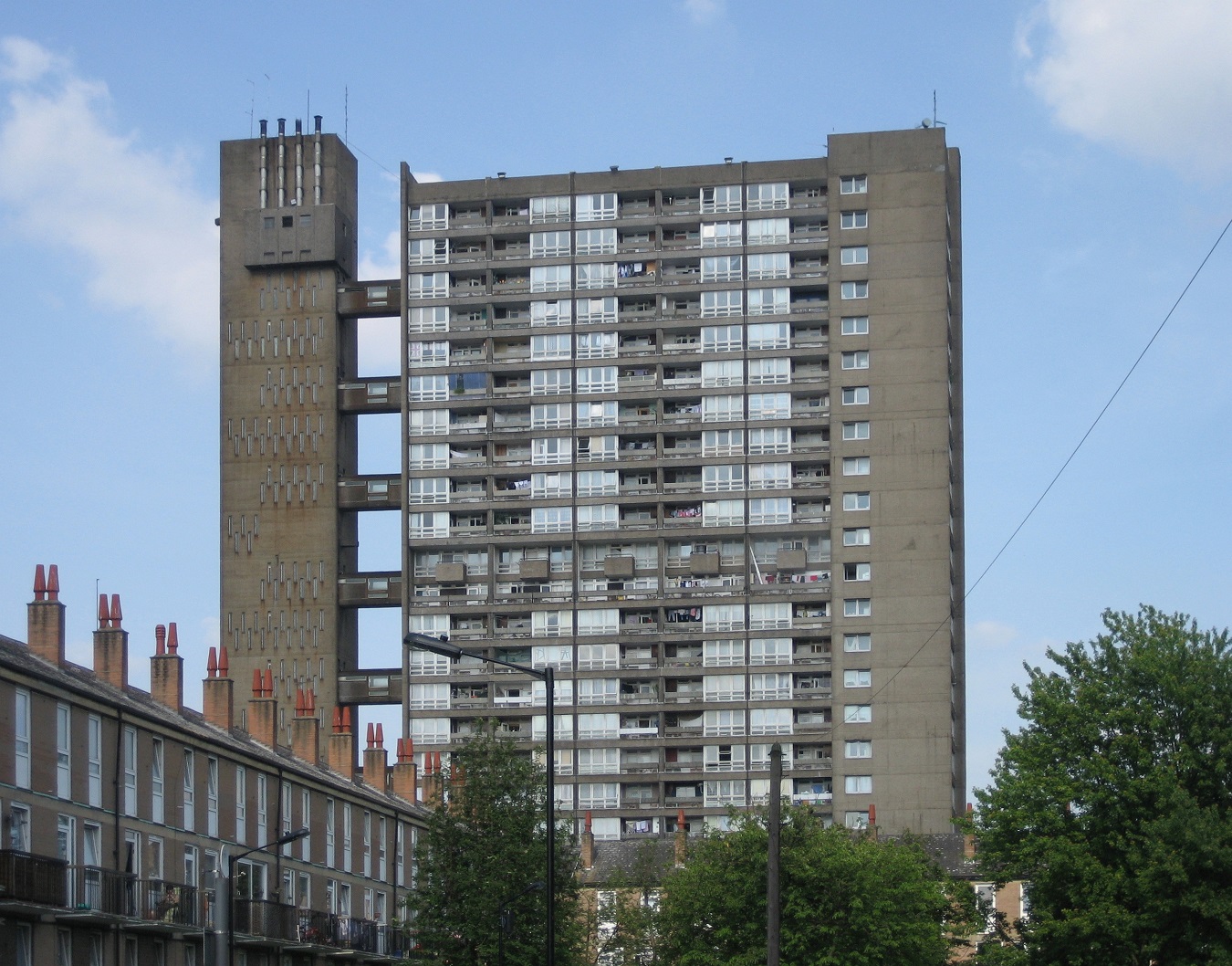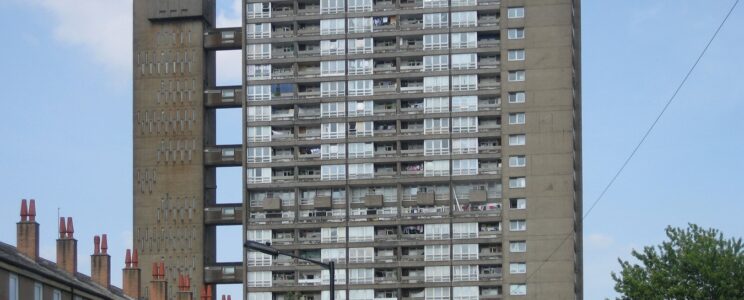J.G. Ballard’s novel “High-Rise,” first published in 1975, is a chilling exploration of societal breakdown within the confines of a luxurious, self-sustaining apartment building. Set in a brutalist high-rise in London, the novel delves into the psychological and social disintegration of its residents, making it a compelling read for those interested in dystopian fiction, social commentary, and psychological drama.
The Setting: A Modernist Utopia Turned Nightmare
The high-rise itself is a central character in the novel. Designed as a modernist utopia, it offers its residents every conceivable convenience: swimming pools, supermarkets, schools, and even a medical center. However, this vertical city quickly becomes a microcosm of society’s darker tendencies. Ballard’s description of the building is stark and clinical, emphasizing its dehumanizing architecture. The building’s design, which was intended to foster community and convenience, instead facilitates isolation and conflict. The physical structure of the high-rise, with its 40 floors segregating the social classes, mirrors the psychological and social divisions among the residents.
The Characters: A Study in Psychological Collapse
The novel follows three main characters: Dr. Robert Laing, a divorced medical school lecturer; Richard Wilder, a television documentary producer; and Anthony Royal, the building’s architect. Each of these characters represents a different aspect of the high-rise’s social strata and offers a unique perspective on the unfolding chaos.
- Dr. Robert Laing: Laing lives on the 25th floor, comfortably situated in the middle of the building’s social hierarchy. Initially, he is detached and indifferent to the growing tensions around him. However, as the situation deteriorates, Laing becomes more primal and involved in the power struggles, highlighting the thin veneer of civility that society maintains.
- Richard Wilder: Wilder resides on the lower floors and becomes increasingly frustrated with his position. He views the high-rise as a documentary subject, initially seeing the chaos as an opportunity for professional advancement. As he climbs the building, literally and metaphorically, his ambition transforms into a desperate and violent quest for power.
- Anthony Royal: Royal, the architect, lives in a penthouse on the top floor. He is the embodiment of the high-rise’s upper echelon and is somewhat of a godlike figure. His creation, intended to be a self-sufficient utopia, becomes his downfall as he becomes ensnared in the very chaos he inadvertently created.
Themes: The Breakdown of Society
Social Stratification: One of the central themes of “High-Rise” is the examination of social stratification. The building’s design inherently divides its inhabitants into social classes, with the wealthiest living on the top floors and the less affluent residing on the lower levels. This physical separation exacerbates existing social tensions, leading to class warfare within the confines of the high-rise. The novel explores how these divisions can lead to the breakdown of social order and the eruption of violence.
Isolation and Community: Despite the high-rise’s many communal facilities, its residents become increasingly isolated from one another. The novel suggests that modern conveniences and technological advancements, rather than bringing people together, can create psychological barriers. The characters’ initial attempts at forming social bonds quickly disintegrate as the pressure of the environment intensifies.
The Primal Instinct: Ballard delves into the idea that beneath the surface of civilized society lies a primal, savage nature. As the high-rise descends into chaos, the residents abandon societal norms and revert to a more primitive state. The novel vividly portrays how quickly human behavior can devolve when stripped of the structures that maintain order.
Technology and Dehumanization: The high-rise, with its advanced technology and modern conveniences, is initially seen as a marvel of modern living. However, Ballard critiques the dehumanizing effects of such an environment. The building’s design, meant to improve the quality of life, instead contributes to the residents’ psychological decline. The novel suggests that over-reliance on technology and artificial environments can alienate individuals from their humanity.

The Narrative Style: A Clinical, Detached Lens
Ballard’s writing style in “High-Rise” is notably clinical and detached, which serves to heighten the sense of unease. His prose is precise and unemotional, mirroring the sterile environment of the building. This narrative style allows Ballard to explore the characters’ descent into madness with a sense of objectivity, making their actions all the more disturbing. The detachment in Ballard’s writing also forces readers to confront the unsettling reality of the high-rise without the cushion of emotional engagement.
Social Commentary: A Reflection of 1970s Britain
“High-Rise” was written during a period of significant social change in Britain. The 1970s were marked by economic hardship, class tension, and a questioning of traditional social structures. Ballard’s novel can be seen as a response to these conditions, using the high-rise as a metaphor for the fragmentation and disillusionment of society. The book’s exploration of class conflict, social isolation, and the fragility of civilization resonates with the socio-political climate of the time.
Modern Relevance: Timeless Themes
While “High-Rise” is rooted in the context of the 1970s, its themes remain relevant today. Issues of social inequality, the impact of technology on human relationships, and the potential for societal collapse are as pertinent now as they were when Ballard wrote the novel. The high-rise can be seen as a precursor to modern discussions about urban living, social isolation, and the psychological effects of high-density environments. The novel’s exploration of these themes continues to resonate with contemporary readers, making it a timeless piece of literature.
The Adaptation: From Page to Screen
In 2015, “High-Rise” was adapted into a film directed by Ben Wheatley and starring Tom Hiddleston as Dr. Robert Laing. The film stays largely faithful to the source material, capturing the novel’s unsettling atmosphere and social commentary. However, as with any adaptation, certain elements are emphasized or altered to suit the medium of film. The visual representation of the high-rise and the performances of the cast bring a new dimension to Ballard’s story, offering both fans of the novel and new audiences a fresh perspective on its themes.
Plot Summary of J.G. Ballard’s “High-Rise”
Setting the Stage:
“High-Rise” takes place in a 40-story luxury apartment building in London, designed to provide everything its residents could need within its confines. The high-rise is equipped with swimming pools, a supermarket, a school, and even a medical clinic, creating a self-sufficient environment. However, this utopian vision quickly deteriorates into chaos.
Introduction of Main Characters:
- Dr. Robert Laing: A medical school lecturer who lives on the 25th floor. He represents the middle-class residents of the building.
- Richard Wilder: A television documentary producer living on the lower floors with his family. He is ambitious and increasingly frustrated with his social position.
- Anthony Royal: The architect of the high-rise, residing in a penthouse on the top floor. He is a symbol of the upper-class residents.
Initial Tensions:
The novel begins with a sense of unease as minor irritations and conflicts among residents start to escalate. Small inconveniences like broken elevators and power outages disproportionately affect the lower floors, while the upper floors remain relatively unscathed. These issues highlight the existing social stratification within the building, setting the stage for further conflict.
Descent into Chaos:
As tensions rise, the residents begin to form tribes based on their floor levels. Social interactions become increasingly hostile, and violence starts to break out. The building’s facilities become battlegrounds, and the initially polite society disintegrates into tribal warfare. The residents abandon their former lives and roles, embracing a primal existence.
- Laing’s Transformation: Dr. Laing, initially detached and indifferent, becomes more involved in the conflicts. He starts to see the high-rise as a microcosm of society and becomes more primal in his behavior. He forms alliances and participates in the power struggles, illustrating the thin veneer of civilization.
- Wilder’s Ambition: Richard Wilder becomes obsessed with climbing to the top of the building, both literally and figuratively. His journey upwards becomes a violent quest for power and dominance. Wilder’s ambition leads him to abandon his family and lose his humanity as he succumbs to the building’s chaos.
- Royal’s Downfall: Anthony Royal, the architect, tries to maintain a semblance of order from his penthouse. However, he becomes increasingly disconnected from reality and is ultimately consumed by the very environment he created. His initial vision of a utopian community turns into a nightmare.
Complete Breakdown:
The novel reaches its climax as the building plunges into anarchy. Normal social behaviors and conventions are abandoned, and the residents revert to a primitive state. The high-rise becomes a lawless environment where survival of the fittest prevails. The lower floors are destroyed and neglected, while the upper floors become isolated fortresses.
- Isolation and Insanity: The residents become increasingly isolated, both physically and psychologically. They form small, insular communities and engage in violent conflicts. The high-rise becomes a closed system, cut off from the outside world, amplifying the madness within.
- Laing’s Acceptance: By the end of the novel, Laing has fully adapted to the new reality of the high-rise. He becomes a part of the primal society, accepting the chaos as the new norm. Laing’s transformation is complete, reflecting the building’s total collapse of order and civility.
Conclusion:
“High-Rise” ends with the high-rise in complete disarray. The once-modern and self-sufficient building is now a dystopian ruin. The residents, having descended into savagery, have no intention of returning to their former lives. The novel concludes on a bleak note, suggesting that the breakdown of societal norms and structures is both inevitable and irreversible.

Themes and Analysis
Social Stratification: The novel explores how physical and social divisions within the high-rise exacerbate existing tensions, leading to conflict and eventual collapse. The residents’ descent into tribalism mirrors broader societal issues of class conflict and inequality.
Isolation: Despite the high-rise’s communal facilities, its residents become increasingly isolated from each other. This isolation contributes to the breakdown of social norms and the rise of violence.
Primal Instincts: Ballard suggests that beneath the veneer of civilization lies a primal nature that can surface under pressure. The residents’ rapid descent into savagery highlights the fragility of social order.
Technological Dependence: The novel critiques the over-reliance on technology and artificial environments, suggesting that such dependence can lead to dehumanization and psychological decline.
Human Nature: “High-Rise” offers a bleak view of human nature, suggesting that in the absence of societal structures, people will revert to a primitive, survivalist state.
In essence, “High-Rise” is a powerful exploration of the dark side of human nature and the fragility of societal structures. It serves as a stark warning about the potential consequences of social inequality, isolation, and technological dependence. The novel’s relevance to contemporary issues makes it a timeless and thought-provoking read.
Why “High-Rise” is Worth Reading
“High-Rise” is a compelling exploration of human nature, societal structures, and the fragility of civilization. Ballard’s masterful storytelling, combined with his incisive social commentary, makes this novel a thought-provoking and disturbing read. The high-rise serves as a powerful metaphor for the potential for chaos inherent in modern society, and the characters’ descent into savagery is a stark reminder of the thin veneer of civility that separates order from anarchy.
For readers interested in dystopian fiction, “High-Rise” offers a unique and chilling perspective on the genre. Its relevance to contemporary issues of social inequality, technological dependence, and urban living ensures that it remains a significant and thought-provoking work. J.G. Ballard’s “High-Rise” is not just a novel about a building; it is a profound commentary on the human condition and the societies we build.
High-Rise
Within the walls of a high-tech forty-storey high-rise, the residents are hell-bent on an orgy of sex and destruction, answering to primal urges that their utopian surroundings can’t satisfy. The high-rise is a would-be paradise turned dystopia, ruled by intimidation and violence, and, as the residents organize themselves for war, floor against floor, no one wants it to stop …
Similar Books to J.G. Ballard’s High-Rise
J.G. Ballard’s High-Rise is a seminal work of dystopian fiction that explores the breakdown of societal norms within a high-rise apartment building. Its themes of social disintegration, class conflict, and the psychological effects of modern architecture have inspired numerous other works of literature. Here, we outline some books that share thematic or stylistic similarities with High-Rise.
Crash by J.G. Ballard
While not another author’s work, it is impossible to discuss High-Rise without mentioning Ballard’s own Crash. This novel delves into the dark intersections of technology, sexuality, and violence, much like High-Rise. Crash explores the lives of individuals obsessed with car accidents and the erotic potential of vehicular destruction, reflecting Ballard’s fascination with the breakdown of modern society and the psychological ramifications of technological advancements.
Concrete Island by J.G. Ballard
Another of Ballard’s works, Concrete Island, is a fitting companion to High-Rise. The novel tells the story of Robert Maitland, an architect who becomes stranded on a traffic island in the middle of a busy highway. This work similarly explores themes of isolation, urban decay, and the psychological effects of modern life. Maitland’s descent into madness on the isolated island parallels the characters’ degeneration in High-Rise.
The Dispossessed by Ursula K. Le Guin
Ursula K. Le Guin’s The Dispossessed offers a profound exploration of societal structures and class divisions, much like High-Rise. Set between two contrasting worlds – one capitalist and the other anarchist – the novel examines how these differing systems impact individuals’ lives and psyches. Le Guin’s nuanced depiction of social dynamics and the psychological implications of societal constructs echo the thematic concerns of Ballard’s work.
The Road by Cormac McCarthy
While markedly different in setting, Cormac McCarthy’s The Road shares with High-Rise a focus on the collapse of society and the struggle for survival. This post-apocalyptic novel follows a father and son navigating a bleak, desolate world, emphasizing themes of human resilience, the breakdown of social order, and the psychological impact of extreme circumstances. McCarthy’s stark, minimalist prose complements the harrowing descent into chaos depicted in Ballard’s novel.
Lord of the Flies by William Golding
William Golding’s Lord of the Flies is a classic examination of the inherent darkness within human nature, akin to the societal breakdown witnessed in High-Rise. The novel’s portrayal of boys stranded on a deserted island who descend into savagery parallels the residents of Ballard’s high-rise who revert to primal behaviors. Both books delve into the fragility of civilization and the thin veneer of order that separates humanity from chaos.
Snow Crash by Neal Stephenson
Neal Stephenson’s Snow Crash is a cyberpunk novel that, while more technologically focused, explores themes of societal fragmentation and the impact of modern developments on human behavior. The novel’s depiction of a dystopian future where corporate control and virtual realities dominate people’s lives resonates with the technological and psychological critiques found in High-Rise. Stephenson’s exploration of virtual and physical spaces’ influence on identity and society parallels Ballard’s architectural and psychological inquiries.
The Ballad of Beta-2 by Samuel R. Delany
Samuel R. Delany’s The Ballad of Beta-2 is a science fiction novel that examines the effects of isolation and societal collapse within a closed environment, similar to the high-rise in Ballard’s novel. The story follows a researcher investigating the remnants of a starship’s failed colonization mission, uncovering the societal and psychological breakdown of its inhabitants. Delany’s intricate exploration of human behavior in confined, isolated spaces complements the themes of High-Rise.
The Cement Garden by Ian McEwan
Ian McEwan’s The Cement Garden shares with High-Rise an intense focus on psychological disintegration within a confined, isolated environment. The novel follows siblings who, after the death of their parents, attempt to live on their own in their decaying house. As their situation deteriorates, so does their mental state, mirroring the psychological collapse of Ballard’s high-rise residents. McEwan’s exploration of human behavior in extreme circumstances echoes the themes of isolation and societal breakdown found in High-Rise.



